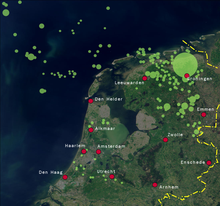Groningen gas field
| Groningen | |
|---|---|
 |
|
| Country | Netherlands |
| Region | Groningen |
| Location | Slochteren |
| Offshore/onshore | onshore |
| Operator | Nederlandse Aardolie Maatschappij BV |
| Field history | |
| Discovery | 1959 |
| Start of development | 1959 |
| Start of production | 1963 |
| Production | |
| Current production of gas | 93×106 m3/d 3.3×109 cu ft/d |
| Estimated gas in place | 2.8×1012 m3 100×1012 cu ft |
The Groningen gas field is a giant natural gas field located near Slochteren in Groningen province in the northeastern part of the Netherlands. Discovered in 1959, it is the largest natural gas field in Europe and the tenth-largest in the world.
After two previous unsuccessful wells were commissioned to search for oil and gas, on 22 July 1959, the Slochteren 1 well, drilling to a depth of 3,000 metres (9,800 ft), discovered the huge 2.8 trillion cubic meters (100 trillion cubic feet) gas field in the porous Rotliegend sandstone formation, which is 130 metres (430 ft) to 140 metres (460 ft) thick and 45 kilometres (28 mi) long from north to south by 25 kilometres (16 mi) long from east to west. The field started production in 1963 and produced around 100 billion cubic meters (3.57 trillion cubic feet) per year in the first decade of production but gradually the annual production fell to around 35 billion cubic meters (1.25 trillion cubic feet) per year. As of 2009[update] the Groningen gas field has produced around 1,700 billion cubic meters (60.7 trillion cubic feet) which represents 60% of the total reserves of the field but the remaining 1,100 billion cubic meters (39.3 trillion cubic feet) are expected to last for another 50 years.
The Groningen gas field is operated by the Nederlandse Aardolie Maatschappij BV (NAM), a joint venture between Royal Dutch Shell and ExxonMobil with each company owning a 50% share. The field accounts for 50% of the natural gas production in the Netherlands, the other 50% being supplied by around 300 smaller gas fields, most of them located offshore in the North Sea.
After demonstrations in Groningen because of the increase in induced earthquakes, whose event count shows an exponential growth in time , the Dutch government decided on January 17, 2014 to cut output from the gas field and pay those affected by the earthquake a compensation worth 1.2 billion Euro, spread over a period of 5 years. The ministry said production would be cut in 2014 and 2015 to 42.5 bcm and in 2016 to 40 bcm.
...
Wikipedia
